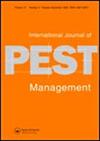Population development of the Colorado potato beetle, Leptinotarsa decemlineata (Coleoptera: Chrysomelidae), under individually- and group-reared conditions
IF 1.1
4区 农林科学
Q3 ENTOMOLOGY
引用次数: 0
Abstract
AbstractThe Colorado potato beetle (CPB) is a serious pest of potato in China. To determine the effect of individual-rearing and group-rearing on its population growth and development, we studied its life tables and projected its population growth using the TWOSEX-MS Chart and TIMING-MS Char programs. Results showed that individually-reared CPBs were significantly better than that of group-reared CPBs, in terms of intrinsic rate of increase (0.07), finite rate of increase (1.07), net reproductive rate (39.93), and gross reproductive rate (221.23) compared to that of group-reared treatment (0.05; 1.05; 10.84; and 58.77). Additionally, individually-reared CPB populations had faster development, characterized by shorter generation cycles, and higher female survival rates, which produced more offspring per unit time, compared to the group-reared CPB population. However, in potato fields, the CPB are mostly found in groups and therefore the group-rearing method should be more effective for prediction and possible management of CPB populations. This study serves as a reference for an effective and biological prevention and control of the CPBs.Keywords: Colorado potato beetlesage-stage two-sex life tableindividual-rearinggroup-rearing AcknowledgmentsThe authors thank J. L. (Juan Liu) and X.L. (Xia Liu), H.Z.H. (Hengzhi Hu), and P.N. (Ping Niu) for their help during this research. Also, they thank LetPub (www.letpub.com) for language editing during the preparation of this manuscript.Author contributionsConceptualization, CL and JHL; Formal Analysis, HHS; Funding Acquisition, CL; Investigation, JHL; Methodology, CL and JHL; Project Administration, CL; Resources, CL; Writing: Original Draft Preparation, HHS; Writing: Review and Editing, CL. All authors read and approved the final manuscript.Disclosure statementThe authors report no conflicts of interest.Data availability statementThe data supporting the conclusions of this article are included within the article and its additional files.Additional informationFundingThis research was supported by the National Key R&D Program of China (2021YFD1400200); the National Natural Science Foundation of China (31660545); China Postdoctoral Science Foundation (2017M613305XB); Key Laboratory of Integrated Management of Crop Pests in Northwest Desert Oasis, Ministry of Agriculture and Rural Affairs (KFJJ201905).科罗拉多马铃薯甲虫,Leptinotarsa decemlineata(鞘翅目:金龟科)在个体和群体饲养条件下的种群发展
摘要科罗拉多马铃薯甲虫(CPB)是中国马铃薯的严重害虫。为了确定个体饲养和群体饲养对其种群生长和发展的影响,我们研究了其生命表,并使用two性别- ms图和TIMING-MS Char程序预测了其种群增长。结果表明:个体饲养的CPBs内在增殖率(0.07)、有限增殖率(1.07)、净繁殖率(39.93)和总繁殖率(221.23)均显著优于群养处理(0.05;1.05;10.84;和58.77)。此外,个体饲养的CPB种群发育更快,代周期更短,雌性存活率更高,单位时间内产生的后代更多。然而,在马铃薯田中,CPB大多是群居的,因此群体饲养方法对CPB种群的预测和可能的管理应该更有效。本研究可为CPBs的有效生物防治提供参考。致谢致谢致谢致谢致谢致谢致谢致谢致谢致谢致谢致谢致谢致谢致谢致谢致谢致谢致谢致谢致谢致谢致谢致谢致谢致谢致谢致谢致谢致谢致谢致谢致谢致谢致谢致谢同时,他们感谢LetPub (www.letpub.com)在本文准备过程中的语言编辑。作者贡献:concepalization, CL和JHL;形式分析,HHS;资金获取,CL;调查,JHL;方法学、CL和JHL;工程管理学院;资源,CL;写作:原始草案准备,卫生与公众服务部;写作:审编,CL。所有作者都阅读并批准了最终的手稿。披露声明作者报告无利益冲突。数据可用性声明支持本文结论的数据包含在本文及其附加文件中。本研究得到国家重点研发计划项目(2021YFD1400200)的支持;国家自然科学基金(31660545);中国博士后科学基金(2017M613305XB);农业农村部西北荒漠绿洲作物有害生物综合治理重点实验室(kfjj20105)。
本文章由计算机程序翻译,如有差异,请以英文原文为准。
求助全文
约1分钟内获得全文
求助全文
来源期刊
CiteScore
4.70
自引率
6.70%
发文量
74
审稿时长
>12 weeks
期刊介绍:
International Journal of Pest Management publishes original research papers and reviews concerned with pest management in the broad sense, covering the control of pests (invertebrates, vertebrates and weeds) and diseases of plants, fungi and their products – including biological control, varietal and cultural control, chemical controland interference methods.
The management of invasive species is of special interest. We also encourage submissions dealing with interactions of multiple pests such as arthropods and plant pathogens, pathogens and weeds or weeds and arthropods as well as those dealing with the indirect and direct effects of climate change on sustainable agricultural practices.

 求助内容:
求助内容: 应助结果提醒方式:
应助结果提醒方式:


